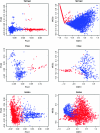Population structure and inbreeding from pedigree analysis of purebred dogs
- PMID: 18493074
- PMCID: PMC2390636
- DOI: 10.1534/genetics.107.084954
Population structure and inbreeding from pedigree analysis of purebred dogs
Abstract
Dogs are of increasing interest as models for human diseases, and many canine population-association studies are beginning to emerge. The choice of breeds for such studies should be informed by a knowledge of factors such as inbreeding, genetic diversity, and population structure, which are likely to depend on breed-specific selective breeding patterns. To address the lack of such studies we have exploited one of the world's most extensive resources for canine population-genetics studies: the United Kingdom (UK) Kennel Club registration database. We chose 10 representative breeds and analyzed their pedigrees since electronic records were established around 1970, corresponding to about eight generations before present. We find extremely inbred dogs in each breed except the greyhound and estimate an inbreeding effective population size between 40 and 80 for all but 2 breeds. For all but 3 breeds, >90% of unique genetic variants are lost over six generations, indicating a dramatic effect of breeding patterns on genetic diversity. We introduce a novel index Psi for measuring population structure directly from the pedigree and use it to identify subpopulations in several breeds. As well as informing the design of canine population genetics studies, our results have implications for breeding practices to enhance canine welfare.
Figures



Comment in
-
The breeding of pedigree dogs: time for strong leadership.Vet J. 2008 Nov;178(2):157-8. doi: 10.1016/j.tvjl.2008.10.004. Vet J. 2008. PMID: 18984476 No abstract available.
References
-
- Agarwala, R., L. G. Biesecker, K. A. Hopkins, C. A. Francomano and A. A. Schaffer, 1998. Software for constructing and verifying pedigrees within large genealogies and an application to the old order Amish of Lancaster County. Genome Res. 8 211–221. - PubMed
-
- Balding, D. J., 2003. Likelihood-based inference for genetic correlation coefficients. Theor. Popul. Biol. 63 221–230. - PubMed
-
- Boattini, A., F. C. F. Calboli, M. J. B. Villegas, P. Gueresi, M. G. Franceschi et al., 2006. Migration matrices and surnames in populations with different isolation patterns: Val di Lima (Italian Apennines), Val di Sole (Italian alps), and La Cabrera (Spain). Am. J. Hum. Biol. 18 676–690. - PubMed
-
- Boichard, D., 2002. Pedig: a fortran package for pedigree analysis suited for large populations. Proceedings of the 7th World Congress on Genetics Applied to Livestock Production, Montpellier, France, pp. 28–13.
Publication types
MeSH terms
Grants and funding
LinkOut - more resources
Full Text Sources
Research Materials

